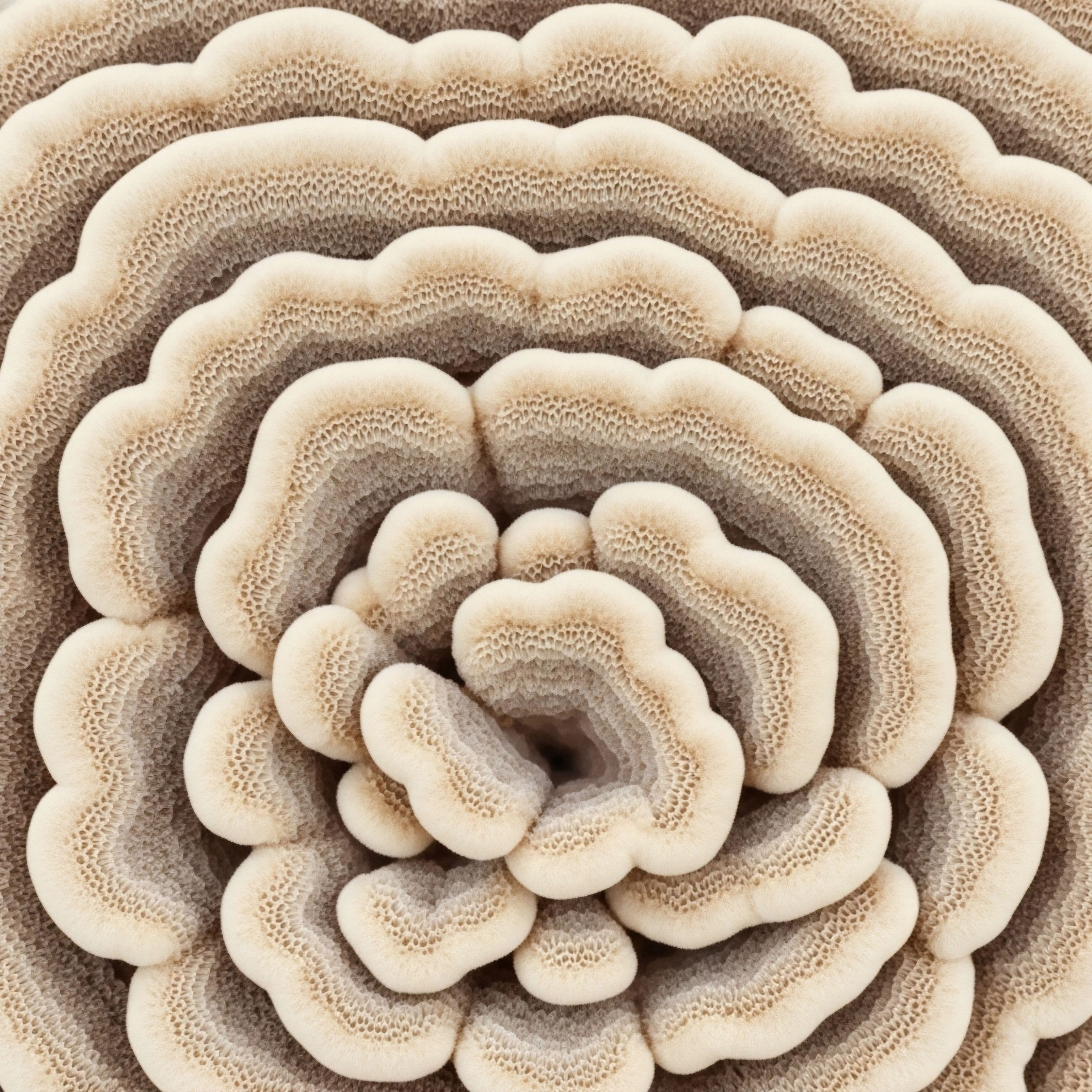

Fundamentals
You may feel a persistent sense of fatigue, a subtle decline in your physical performance, or a general feeling that your vitality is waning. These experiences are valid and deeply personal, often pointing toward underlying shifts in your body’s intricate hormonal symphony.
Your body is a complex, interconnected system, and understanding its language is the first step toward reclaiming your sense of well-being. We can begin this journey by looking at a specific, powerful component of that system ∞ the role of essential fats in male endocrine health. Specifically, we will examine how omega-3 fatty acids, the foundational building blocks found in sources like fish oil, directly support the function of your testicles.
The testicles are sophisticated endocrine organs responsible for more than just reproduction. They are the primary manufacturing plants for testosterone, the hormone that governs male physiology, influencing everything from muscle mass and bone density to mood and cognitive function.
The health and efficiency of these factories depend entirely on the quality of the raw materials they receive and the integrity of their own cellular machinery. This is where omega-3 fatty acids come into the picture. Think of them as specialized, high-grade components essential for building and maintaining a high-performance facility.
At the most basic level, your body is composed of trillions of cells, and every single cell is encased in a membrane. This membrane is a fluid, flexible barrier made primarily of fats, or lipids. The type of fat you consume directly influences the composition and function of these membranes.
Omega-3 fatty acids, particularly docosahexaenoic acid (DHA), are a unique type of polyunsaturated fat. Their molecular structure, with its multiple double bonds, imparts a remarkable degree of fluidity and flexibility to the cell membranes where they are incorporated. The testicular cells, and especially the sperm cells they produce, have some of the highest concentrations of DHA in the entire male body.
This is a direct reflection of their specialized function. A sperm cell’s membrane needs to be exceptionally fluid and dynamic to navigate its environment and successfully fuse with an egg. Incorporating DHA ensures this structural integrity, making it a non-negotiable element for healthy sperm architecture.
Omega-3 fatty acids serve as essential structural components for the membranes of testicular and sperm cells, directly influencing their function.
Beyond their structural role, these essential fats also participate in cellular communication. The cell membrane is dotted with receptors and signaling molecules that transmit instructions from the outside world, including hormonal signals, to the cell’s interior. The fluidity of the membrane, governed by its fatty acid composition, affects how these receptors move, cluster, and function.
A rigid, unhealthy membrane built from less optimal fats can impede this communication, much like a stiff, rusted lock is difficult to open. By ensuring membrane fluidity, omega-3s help maintain clear and efficient signaling pathways, allowing testicular cells to respond appropriately to hormonal cues from the brain.
This foundational role in both structure and communication makes omega-3s a critical factor in supporting the very core of male hormonal health. Understanding this relationship provides a powerful insight ∞ the choices you make about your nutrition have a direct and measurable impact on the fundamental biology of your vitality.


Intermediate
Building upon the foundational knowledge that omega-3s are integral to cellular structure, we can now examine the specific mechanisms through which they influence testicular function and, by extension, testosterone production. This process involves a sophisticated interplay between cellular health, inflammatory balance, and the body’s master hormonal control system. Your journey to wellness is about understanding these interconnected systems so you can provide your body with the precise support it needs to function optimally.

The Cellular Machinery of Testosterone Production
Within the testicles, specialized cells known as Leydig cells are the exclusive sites of testosterone synthesis. This biochemical process is a multi-step conversion that begins with cholesterol. The efficiency of this conversion is highly dependent on the health of the Leydig cell and its internal organelles, particularly the mitochondria and the endoplasmic reticulum.
The membranes of these organelles, just like the outer cell membrane, are built from the fats available in your diet. A high concentration of DHA within these membranes is thought to facilitate the activity of the enzymes that drive testosterone production.
Think of it as upgrading the assembly line in your hormonal factory with perfectly calibrated, high-performance parts. The presence of these fats ensures that the enzymatic machinery responsible for converting cholesterol into pregnenolone, and subsequently into testosterone, operates smoothly and without hindrance.
Studies in overweight and obese men have shown that supplementation with DHA-enriched fish oil can lead to an increase in circulating testosterone levels, suggesting a direct link between this specific omega-3 and the output of the Leydig cells.

What Is the Role of the HPG Axis?
Your body’s hormonal systems operate on a feedback loop, much like a thermostat regulating room temperature. The primary control system for testicular function is the Hypothalamic-Pituitary-Gonadal (HPG) axis. Here is how this communication network functions:
- The Hypothalamus ∞ This region of the brain acts as the command center. It monitors testosterone levels in the blood. When levels are low, it releases Gonadotropin-Releasing Hormone (GnRH).
- The Pituitary Gland ∞ GnRH travels a short distance to the pituitary gland, instructing it to release two key signaling hormones ∞ Luteinizing Hormone (LH) and Follicle-Stimulating Hormone (FSH).
- The Testes ∞ LH travels through the bloodstream to the testicles, where it binds to receptors on the Leydig cells, directly stimulating them to produce and release testosterone. FSH, concurrently, acts on another set of cells, the Sertoli cells, to support sperm production.
Omega-3 fatty acids can influence this delicate axis. Research indicates that men taking fish oil supplements often show lower levels of LH and FSH for a given level of testosterone. This suggests that their testicular “factories” have become more efficient or sensitive to the hormonal signals they receive.
With a more efficient system, the brain does not need to “shout” as loudly (by releasing high levels of LH) to achieve the desired testosterone output. This indicates a healthier, more responsive HPG axis, a hallmark of robust endocrine function.

The Critical Balance of Fats and Inflammation
The conversation about omega-3s is incomplete without mentioning their relationship with omega-6 fatty acids. Both are essential, meaning your body cannot produce them. However, modern diets are often excessively high in omega-6s (found in vegetable oils, processed foods) and deficient in omega-3s.
This imbalance is problematic because these two types of fats are precursors to local signaling molecules called eicosanoids. Omega-6s are typically converted into pro-inflammatory messengers, while omega-3s are converted into anti-inflammatory ones. Chronic, low-grade inflammation, driven by an imbalanced omega-6 to omega-3 ratio, can impair cellular function throughout the body, including in the testicles.
Testicular tissue is particularly vulnerable to oxidative stress and inflammation, which can damage Leydig cells and reduce their testosterone-producing capacity. By increasing your intake of omega-3s, you are providing the raw materials to actively counterbalance this inflammatory state, protecting the delicate machinery of hormone production from damage.
A healthy ratio of omega-3 to omega-6 fatty acids is essential for managing inflammation and protecting testicular cells from oxidative damage.
This protective, anti-inflammatory role is a cornerstone of how omega-3s support testicular health. They are not just passive building blocks; they are active participants in creating a cellular environment conducive to optimal function. This understanding moves us from a simple model of supplementation to a more sophisticated strategy of systemic balance, where nutritional choices directly contribute to the resilience and efficiency of our most vital hormonal systems.
| Fatty Acid | Primary Role | Mechanism Of Action | Relevance To Testicular Function |
|---|---|---|---|
| DHA (Docosahexaenoic Acid) | Structural Integrity |
Incorporates into cell membranes, increasing fluidity and flexibility. It is the most abundant omega-3 in the brain and testes. |
Essential for the membrane health of Leydig cells and the structural formation of sperm. Supports efficient enzymatic conversion of cholesterol to testosterone. |
| EPA (Eicosapentaenoic Acid) | Anti-Inflammatory Signaling |
Serves as a precursor to potent anti-inflammatory molecules, including resolvins and E-series prostaglandins. |
Helps counteract chronic, low-grade inflammation within testicular tissue, protecting Leydig cells from damage and preserving their function. |


Academic
A comprehensive analysis of the influence of omega-3 polyunsaturated fatty acids (PUFAs) on testicular function requires a multi-faceted examination of their roles in membrane biophysics, the active resolution of inflammation, and the modulation of nuclear receptor signaling. These pathways converge to create a biochemical environment that dictates the steroidogenic capacity and overall health of the gonadal tissue. This exploration moves beyond general associations and into the precise molecular mechanisms that position omega-3s as critical regulators of male endocrinology.

Membrane Fluidity and Steroidogenic Acute Regulatory Protein (StAR) Function
The primary regulator of testosterone synthesis is the delivery of the precursor molecule, cholesterol, from the outer mitochondrial membrane to the inner mitochondrial membrane within Leydig cells. This rate-limiting step is mediated by the Steroidogenic Acute Regulatory Protein (StAR). The function of StAR is exquisitely sensitive to the biophysical properties of the mitochondrial membranes.
The incorporation of DHA, with its highly unsaturated and flexible acyl chain, into the phospholipid bilayer of the mitochondria increases membrane fluidity. This enhanced fluidity is hypothesized to facilitate the conformational changes and protein-protein interactions required for StAR to efficiently dock and transport cholesterol.
A rigid membrane, characteristic of one with a lower DHA content and higher saturated fat content, would impede this process, creating a bottleneck in the steroidogenic pathway. Therefore, the abundance of DHA in Leydig cell membranes is a direct determinant of the cell’s maximum potential for testosterone production, independent of the initial hormonal stimulus from Luteinizing Hormone (LH).

How Do Omega-3s Mediate the Resolution of Inflammation?
Chronic subclinical inflammation is a potent suppressor of testicular function. Inflammatory cytokines like Tumor Necrosis Factor-alpha (TNF-α) and Interleukin-6 (IL-6) have been shown to directly inhibit the expression of steroidogenic enzymes, such as P450scc and 3β-HSD, within Leydig cells, thereby reducing testosterone output. The role of omega-3s in this context is far more sophisticated than simple anti-inflammation; they are precursors to a class of endogenous molecules known as Specialized Pro-Resolving Mediators (SPMs).
SPMs, which include resolvins, protectins, and maresins, are enzymatically derived from EPA and DHA. Their function is to actively orchestrate the resolution of inflammation, a process involving the cessation of neutrophil infiltration, the stimulation of non-phlogistic macrophage phagocytosis of apoptotic cells and debris, and the restoration of tissue homeostasis. This is a biologically active “clean-up” process.
The mechanism is highly specific:
- Resolvin E1 (from EPA) ∞ Binds to the ChemR23 receptor, which has been identified in testicular tissue. Activation of this receptor blocks the infiltration of inflammatory cells and reduces the production of pro-inflammatory cytokines.
- Protectin D1 (from DHA) ∞ Also known as neuroprotectin D1 when in neural tissue, this SPM has potent protective effects. It inhibits inflammatory signaling cascades and promotes cell survival in the face of oxidative stress, a common feature of testicular inflammation (orchitis).
By providing the necessary substrates for SPM biosynthesis, a diet rich in omega-3s equips the body with the tools to actively resolve testicular inflammation. This protects the steroidogenic machinery from cytokine-induced suppression and preserves the functional capacity of the Leydig cell population over time. This active resolution is a key mechanism separating the action of omega-3s from conventional anti-inflammatory agents.

Modulation of Gene Expression through PPARs
Peroxisome Proliferator-Activated Receptors (PPARs) are a family of nuclear receptors that function as transcription factors. When activated by a ligand, they bind to specific DNA sequences and modulate the expression of a host of genes involved in lipid metabolism, glucose homeostasis, and inflammation. Omega-3 fatty acids and their derivatives are natural ligands for PPARs, particularly PPARα and PPARγ.
This interaction has profound implications for testicular function:
- PPARα Activation ∞ Primarily expressed in tissues with high fatty acid oxidation rates like the liver and heart, PPARα activation by omega-3s helps improve systemic lipid profiles and reduce circulating triglycerides. This metabolic improvement can indirectly support testicular function by enhancing overall metabolic health and insulin sensitivity, which are tightly linked to the HPG axis.
- PPARγ Activation ∞ While most known for its role in adipocyte differentiation, PPARγ is also expressed in other tissues, including immune cells. Activation of PPARγ by omega-3s exerts powerful anti-inflammatory effects by repressing the expression of pro-inflammatory genes. This provides another layer of protection for testicular tissue against inflammatory damage.
Through their action on PPARs, omega-3s function as systemic metabolic regulators. They are not merely nutrients but signaling molecules that communicate the body’s lipid status to the genome, prompting adaptive changes that favor metabolic efficiency and inflammatory control. This systemic effect creates a favorable internal environment for the HPG axis to operate without interference from metabolic dysfunction or chronic inflammation.
Omega-3 fatty acids act as signaling molecules that activate nuclear receptors, directly influencing gene expression related to metabolism and inflammation.

Systemic Integration and the HPG Axis
The health of the Hypothalamic-Pituitary-Gonadal axis is inseparable from the body’s overall metabolic and inflammatory state. High levels of insulin resistance and chronic inflammation, often associated with a high omega-6 to omega-3 ratio, can disrupt the pulsatile release of GnRH from the hypothalamus and blunt the sensitivity of the pituitary and gonads to their respective signals.
By improving insulin sensitivity, reducing systemic inflammation via SPM production, and modulating gene expression through PPARs, omega-3 fatty acids help to “clean up the signal” across the entire HPG axis. This results in a more robust and resilient endocrine system, capable of maintaining homeostasis and responding appropriately to physiological demands. The observed improvements in testicular function are thus the downstream result of a cascade of benefits that begin at the cellular membrane and extend to systemic metabolic regulation.
| Mechanism | Key Omega-3 | Target | Molecular Outcome | Physiological Consequence |
|---|---|---|---|---|
| Membrane Biophysics | DHA |
Leydig Cell Mitochondrial Membrane |
Increased membrane fluidity and flexibility. |
Enhanced efficiency of StAR-mediated cholesterol transport, optimizing the rate-limiting step of testosterone synthesis. |
| Inflammation Resolution | EPA & DHA |
Enzymatic conversion to SPMs (Resolvins, Protectins) |
Activation of pro-resolving pathways; inhibition of neutrophil infiltration; stimulation of macrophage efferocytosis. |
Active suppression and resolution of testicular inflammation, protecting Leydig cells from cytokine-induced damage. |
| Nuclear Receptor Activation | EPA & DHA |
PPARα and PPARγ |
Modulation of gene transcription related to lipid metabolism and inflammation. |
Improved systemic metabolic health and reduced inflammatory tone, creating a favorable environment for HPG axis function. |

References
- Jensen, Tina Kold, et al. “Associations of Fish Oil Supplement Use With Testicular Function in Young Men.” JAMA Network Open, vol. 3, no. 1, 2020, p. e1919462.
- Abbott, K. et al. “Dietary supplementation with docosahexaenoic acid rich fish oil increases circulating levels of testosterone in overweight and obese men.” Prostaglandins, Leukotrienes and Essential Fatty Acids, vol. 163, 2020, p. 102204.
- Serhan, Charles N. “Resolvins and protectins ∞ mediating solutions to inflammation.” British Journal of Pharmacology, vol. 158, no. 4, 2009, pp. 970-981.
- Georgiou, K. et al. “High fat diet dysregulates hypothalamic-pituitary axis gene expression levels which are differentially rescued by EPA and DHA ethyl esters.” Molecular Metabolism, vol. 28, 2019, pp. 109-122.
- Thesing, C. et al. “Omega-3 polyunsaturated fatty acid levels and dysregulations in biological stress systems.” Psychoneuroendocrinology, vol. 97, 2018, pp. 205-213.
- Hasan, K. and M. Das. “Are fish oil omega-3 long-chain fatty acids and their derivatives peroxisome proliferator-activated receptor agonists?” Hypothesis, vol. 6, no. 1, 2008, pp. 1-6.
- Salas-Huetos, Albert. “More Evidence of the Association of Diet With Human Testicular Function ∞ Fish Oil Supplements.” JAMA Network Open, vol. 3, no. 1, 2020, p. e1919526.
- Abbasihormozi, S. et al. “The effect of omega3 fatty acid supplementation on PPARγ and UCP2 expressions, resting energy expenditure, and appetite in athletes.” Lipids in Health and Disease, vol. 19, no. 1, 2020, p. 138.

Reflection
The information presented here illuminates the profound connection between targeted nutrition and the intricate workings of your endocrine system. Seeing how a single class of molecules, the omega-3 fatty acids, can influence everything from the physical structure of a cell to the genetic expression within its nucleus, offers a new perspective on health.
It moves the conversation from one of passive aging to one of proactive biological maintenance. This knowledge is a tool, providing you with a deeper understanding of your own physiology. Your personal health narrative is unique, and this scientific framework is intended to empower your conversations with a qualified clinical professional. The path to sustained vitality is a personalized one, built upon a foundation of understanding how to support your body’s inherent design for optimal function.

Glossary

omega-3 fatty acids

fatty acids

dha

signaling molecules that

cell membrane

membrane fluidity

testosterone production

testicular function

testosterone synthesis

leydig cells

luteinizing hormone

endocrine function

hpg axis

omega-6 to omega-3 ratio

signaling molecules

protecting leydig cells from

steroidogenic acute regulatory protein

leydig cell

specialized pro-resolving mediators

epa

testicular inflammation

ppars

hypothalamic-pituitary-gonadal axis




